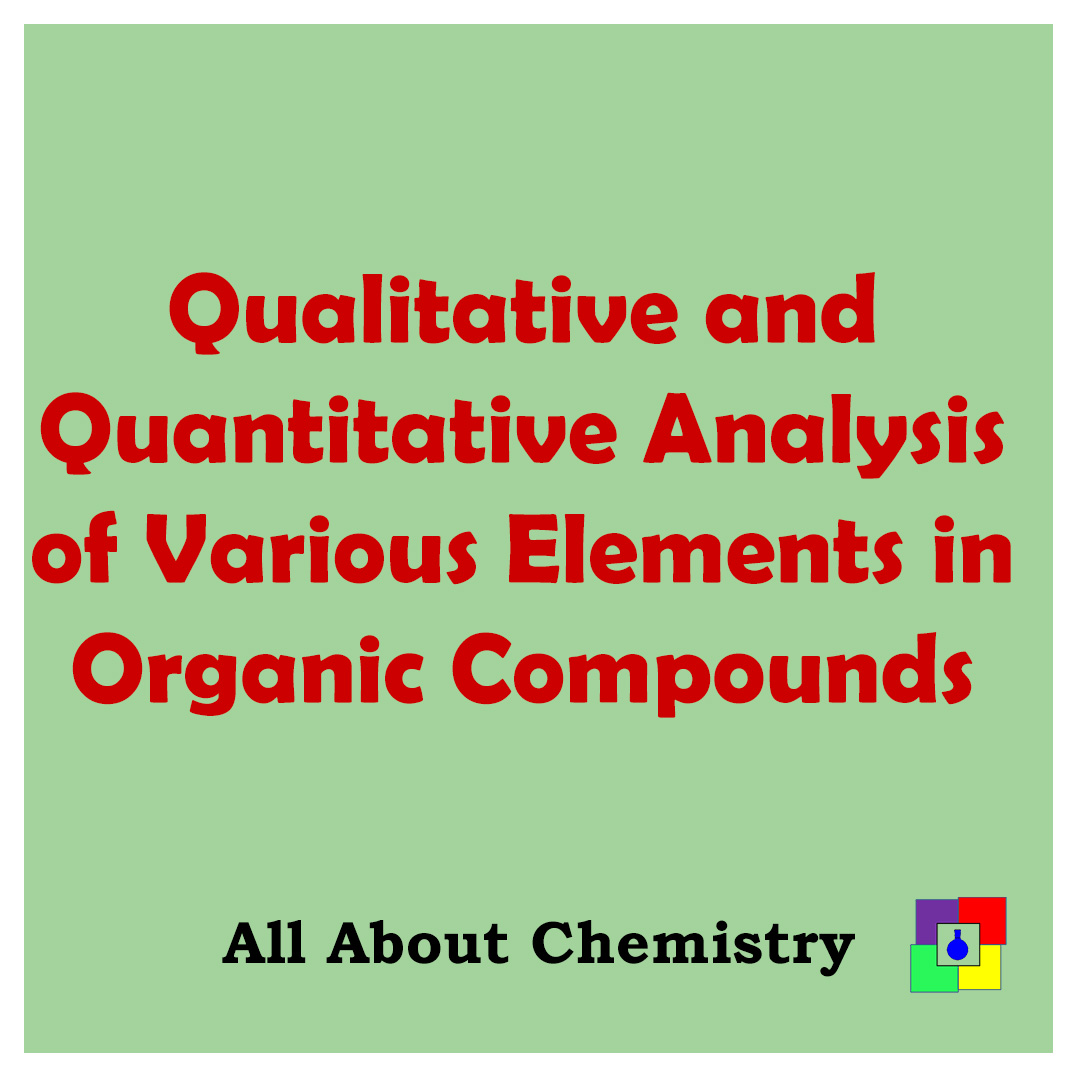In this chapter, we will discuss the Qualitative and Quantitative Analysis of Various Elements in an Organic Compound. In Qualitative Analysis we try to identify which element is present and in the quantitative analysis, we try to calculate the % amount of that particular element present in an organic compound. Organic Compounds by default are made up of Carbon and Hydrogen. This chapter is crucial for both Boards and competitive exams.
Qualitative Analysis of Various Elements in Organic Compound
1. Detection of Carbon and Hydrogen.
The organic Compound is heated with dry CuO in a hard glass test tube .When C is converted to CO2 and H to water.
C + 2CuO→CO2 + 2Cu ;
2H + CuO→H2O + Cu
Carbon dioxide turns lime water milky and water turns white anhydrous CuSO4 blue.
2.Detection of Nitrogen , Sulphur and Halogens
Lassaigne’s Test: Small pea-sized sodium is heated gently in a fusion tube until it forms a shining globule. A small amount of the sample is added to it and the fusion tube is reheated to red hot. It is then, plunged in a mortar with 10-15 mL water and nicely grinded. Filtered hot. The filtrate is known as sodium extract (S.E) or lassaigne’s extract.
| Element | Sodium Extract | Procedure | Reaction |
| Nitrogen | Na+C+N → NaCN(S.E.) | S.E. + FeSO4 + NaOH then boil and cool + FeCl3 + conc.HCl → Blue or green colour | 1)FeSO4 + 2NaOH→Fe(OH)2 + Na2SO4 2)Fe(OH)2 + 6NaCN→Na4[Fe(CN)6] + 2NaOH 3)Na4[Fe(CN)6] + FeCl3 →NaFe[Fe(CN)6] + 3NaCl prussian blue or 3Na4[Fe(CN)6]+FeCl3 →Fe4[Fe(CN)6]3+ 2NaCl prussianblue |
| Sulphur | 2Na + S →Na2S(S.E.) | 1. S.E. + sodium nitro prusside→A deep violet colour. 2. S.E.+ CH3COOH + (CH3COO)2Pb→black ppt. | Na2S + Na2[Fe(CN)5NO]→Na4[Fe(CN)5NOS](deep violet) Na2S + (CH3COO)2Pb →PbS↓+2CH3COONa(Black ppt) |
| Halogen | Na + Cl→NaCl(S.E.) | S.E. + HNO3 + AgNO3 1.White ppt soluble in aq NH3 confirms Cl 2.Pale Yellow ppt. partially soluble in excess aq. NH3 confirms Br. 3.Yellow ppt insoluble in aq NH3 confirms I | NaX + AgNO3→AgX↓(white ppt) AgCI + 2NH3(aq)→[Ag(NH3)2]Cl(soluble) |
| Nitrogen and Sulphur | Na+C+N+S→NaCNS (S.E.) | As in test for nitrogen; instead of green or blue colour, blood red coloration confirms presence of N and S both. | NaCNS + FeCl3→ [Fe(CNS)]Cl2 + NaCl(blood red colour) |
Quantitative analysis of Elements in Organic Compounds

Important Information
- The Kjeldahl method is not used for compounds having nitro groups, azo groups (-N=N-), nitroso ( -NO), azoxy (-N=NO-) and nitrogen in the ring (pyridine, quinoline) as nitrogen in these compounds is not quantitatively converted into ammonium sulphate.
- To detect Beilstein test can be done. Where a clean copper is heated with halides. Blue or green colour conclude the presence of chlorine, bromine or iodine.
- But this test is not used as compounds like urea and thiourea also shows the same colour. CuF2 does not respond to this test. This test does not distinguish between Cl, Br or I.
- Li is not used in Lassaigne’s test because it reacts slowly and its compounds are covalent. Potassium reacts violently, thus is not used.
- Hydrazine does not respond to Lassaigne’s test as it does not contain carbon. Diazonium salts liberate nitrogen before fusing with Na.
- Before testing for halogens, S.E is boiled with conc nitric acid so that NaCN and Na2S if present get destroyed. Otherwise, they will form ppt and interfere with the observation.AgNO3 + NaCN → AgCN↓ + NaNO3 , 2AgNO3 + Na2S → Ag2S ↓ + 2 NaNO3
- During the detection of nitrogen, HCl is added to the S.E to destroy green colour Fe(OH)2 present in the reaction mixture.
- During the detection of halogen, sulphuric acid is not used instead of nitric acid, as there may be a chance of formation of white Ag2SO4, which interfere with white AgCl.
- Oxygen can be detected indirectly by the iodine method. An organic compound containing oxygen is heated with graphite, and CO formed is quantitatively converted into CO2 on reaction with I2O5 . O% = (16 x Wt of CO2 x 100)/ (44 x w)
Numericals
- On complete combustion, 0.246 g of an organic compound gave 0.198 g of CO2 and 0.1014g of water. Determine the percentage of C and H in the compound. [21.95,4.58]
- 0.6723 g of an organic compound gave on combustion 1.530g of carbon dioxide and 0.625g of water. Determine the percentage of C and H in the compound. [62.07,10.33]
- 0.465 g of an organic compound gave on combustion 1.32g of carbon dioxide and 0.315g of water. Determine the percentage of C and H in the compound. [77.42,7.53]
- 0.2475 g of an organic compound gave on combustion 0.495g of carbon dioxide and 0.2025g of water. Determine the percentage of C and H in the compound. [54.54,9.09]
- In Dumas method for estimation of nitrogen, 0.30g of an organic compound gave 50mL of nitrogen collected at 300K and 715 mm of pressure. Calculate the percentage composition of nitrogen in the compound.(Aq tension= 15mm) [17.46]
- In Dumas method for estimation of nitrogen, 0.2046g of an organic compound gave 30.4mL of nitrogen collected at 288K and 732.7 mm of pressure. Calculate the percentage composition of nitrogen in the compound.(Aq tension= 12.7mm) [ 16.68]
- During the estimation of nitrogen present in an organic compound by Kjeldhal’s method, the ammonia evolved from 0.5g of the compound neutralizes 10mL of 1M H2SO4. Find the percentage of nitrogen in the compound. [56.0]
- During the estimation of nitrogen present in an organic compound by Kjeldhal’s method, the ammonia evolved from 0.2g of the compound neutralizes 20mL of 0.1N H2SO4. Find the percentage of nitrogen in the compound. [14]
- During the estimation of nitrogen present in an organic compound by Kjeldhal’s method, the ammonia evolved from 0.4422g of the compound neutralizes 50mL of 0.5 M H2SO4.the residual acid required 131mL of 0.25M NaOH.Find the percentage of nitrogen in the compound. [54.61]
- In Carius method of estimation of halogens, 0.15g of an organic compound gave 0.12g of AgBr. Find the percentage of Bromine in the compound. [34.04]
- In Carius method of estimation of halogens, 0.189g of an organic compound gave 0.287g of AgCl. Find the percentage of chlorine in the compound. [37.57]
- In Carius method of estimation of halogens, 0.301g of an organic compound gave 0.282g of AgBr. Find the percentage of Bromine in the compound. [39.87]
- In sulphur estimation, 0.157g of an organic compound gave 0.4813g of barium sulphate. What is the % of S in the compound? [42.10]
- In sulphur estimation, 0.2175g of an organic compound gave 0.5825g of barium sulphate. What is the % of S in the compound? [36.78]
- In sulphur estimation, 0.16g of an organic compound gave 0.35g of barium sulphate. What is the % of S in the compound? [30.04]
- In sulphur estimation, 0.2595g of an organic compound gave 0.25g of barium sulphate. What is the % of S in the compound? [13.23]
- 0.12g of an organic compound containing P gave 0.22g of Mg2P2O7 by the usual analysis. Calculate the % of P in the compound. [51.20]
- 0.092g of an organic compound containing P gave 0.111g of Mg2P2O7 by the usual analysis. Calculate the % of P in the compound. [33.7]
- 0.40g of an organic compound containing P gave 0.555g of Mg2P2O7 by the usual analysis. Calculate the % of P in the compound. [38.75]















